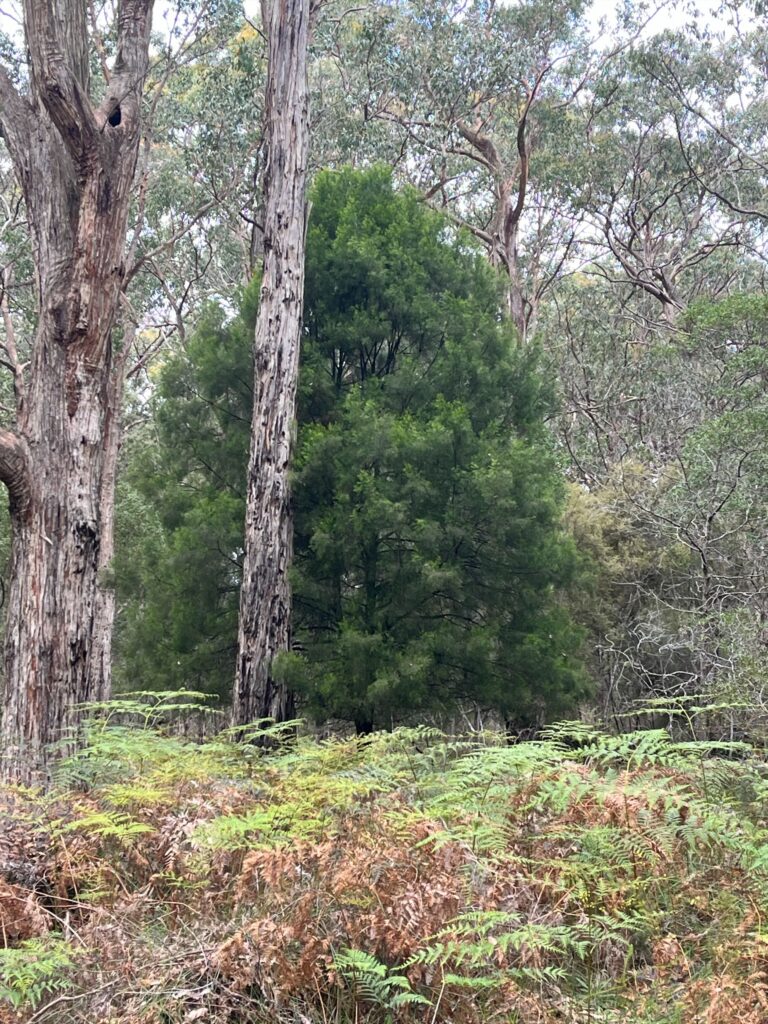Parasites in our midst – the Cherry Ballart (Exocarpus cupressiformus)
Ecologists, much like toddlers, are always asking ‘but why?”. The complexity of the natural world is fascinating and the questions are endless. Hence, I found myself driving through the Cobboboonee forest looking at the many the delightful Cherry Ballart trees (Exocarpus cupressiformus) and wondering why this lovely small native tree isn’t cultivated more widely as a garden plant, or even for revegetation, given how common and widespread it is. Not a deep ecological question but the answer is definitely tied to ecology!
As the species name ‘cupressiformus‘ (‘cypress-form’) implies Cherry Ballart is a neat little tree (6-8m tall) with a cypress like look and shape. Its familiarity of form was well documented by early Europeans. In fact, it was one of the first Australian plants described formally by Europeans, in 1800, when Labillardière gave it its scientific name. The Traditional Owners of course were very familiar with the plant, which is widespread across Eastern Australia and known by a range of traditional names, with both the wood, fruit and sap utilised for various purposes. Muller (2018) notes indigenous names including – Tchimmi-dillen (Queensland), Palatt or Ballot (Tae Rak, Victoria) and Ballee (Yarra).
A relative of Sandalwood and Quandong, it is also a root parasite, actually a hemiparasite, so, while it is not entirely dependent on its hosts for all its nutritional requirements, it does get a valuable boost of nutrients, water and minerals from its host plant. They favour shallow soil types, which presumably allow for easier connection to the roots of host plants, and as these soils are often depauperate in nutrients, they get some significant benefits from the adaptation.
Given their widespread distribution, and distinctive form, they are surely one of the most recognisable, and largest of Australia’s diversity of parasitic plants.
The hosts of Cherry Ballart include a range of Acacias and Eucalypts but there is no reason to expect that other plants wouldn’t also serve as useful host plants. The ‘cherries’ on the plant are not actually fruit, but a swollen stem segment, with both colour and taste intended to attract birds, which, in consuming the fruit also swallow the seed, performing three useful functions for the plant. Firstly, dispersal – transporting the seed to a new location, where it can germinate and grow with less competition. Secondly – treating the seed via the bird’s digestive system to crack the hard coating, and thirdly depositing the seed right next to a suitable host plant, when the bird perches. As the photo above shows, generally we do see them growing right alongside a larger Eucalypt or wattle.
The browse line we commonly see shows that the leaves are certainly palatable, the photo below shows the browse line along a neat roadside stand. It is not uncommon for parasitic plants to have more nutritious foliage than other plants, making them an important food source for a range of species. The role of Cherry Ballart in the ecosystem is poorly documented and researched, unlike the more fully studied Mistletoes, so there is still much to be discovered about interactions between this plant and the birds, mammals and invertebrates that use it as a food source and habitat.
But as to my original musings, it’s unlikely that we will be finding them in the local native plant nursery anytime soon. The seed of the Cherry Ballart are difficult to germinate, benefiting most from passing through the digestive system of a bird, and are also difficult to strike from cuttings. The added complexity of propagating a root parasite means it also has to be germinated alongside a suitable host plant to thrive. While both Quandong and Sandalwood are grown commercially in plantations, this is generally achieved by direct seeding after the host plants are well established, so it’s possible that Cherry Ballarts could be direct seeded into revegetation. For now though, the birds are doing a great job of propagation and dispersal, but I’ve got even more questions…



